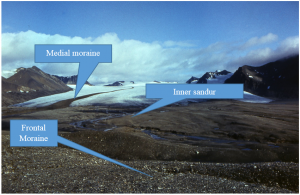Sandur
Sandur or outwash plain is formed of glacial sediments deposited by meltwater outwash at the end or snout of a glacier. Sandurs consist of sand and gravel that the glacier has grinded from the underlying rock surface as it flows. The sand is carried over the outwash plain during floods or trapped inside drifting ice where when melts deposits.
The word sandur is derived from the Icelandic language where the largest outwash plain in the world can be found Skeiðarársandur (1,300 km2).
Sandurs can be divided into outer and inner:
- Outer sandur, formed near the terminal moraine by waters of a glacial river, which cut through a belt of frontal morianes (photos 1 and 2).
- Inner sandur, formed at the glacier’s snout, between its front and the belt of terminal moraine during a fast retreat of the glacier (photo 3).
- Photo 1. Moraines and sandurs at the Gøs glacier forefield, (Hornsund , Spitsbergen). Aerial photograph, NPI 1990
- Photo 2. Outer sandur at the snout of Gøs glacier, Hornsund, Spitsbergen. Photo JG.
- Photo 3. Inner sandur at the snout of the Werenskiold glacier, Spitsbergen. Photo JG.





 This project (EDU-ARCTIC) has received funding from the European Union’s Horizon 2020 research and innovation programme under grant agreement No 710240. The content of the website is the sole responsibility of the Consortium and it does not represent the opinion of the European Commission, and the Commission is not responsible for any use that might be made of information contained.
This project (EDU-ARCTIC) has received funding from the European Union’s Horizon 2020 research and innovation programme under grant agreement No 710240. The content of the website is the sole responsibility of the Consortium and it does not represent the opinion of the European Commission, and the Commission is not responsible for any use that might be made of information contained.